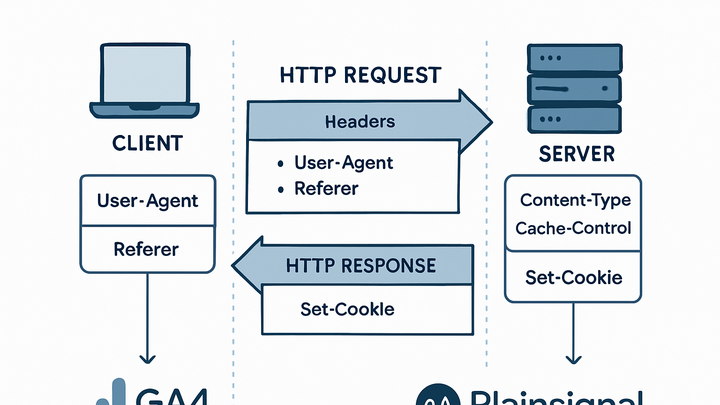Published on 2025-06-28T05:35:11Z
What is an HTTP Header? Examples in Web Analytics
HTTP headers are key-value metadata sent in HTTP requests and responses, conveying information about the
client, server, and resource. In web analytics, headers like User-Agent,
Referer, and cookies help tools identify devices, track traffic sources, and manage sessions.
Security and privacy controls—such as CORS and caching—are also enforced through headers. Analytics
platforms may leverage headers directly (e.g., IP via X-Forwarded-For) or indirectly via HTML
attributes affecting header behavior.
For example, PlainSignal’s lightweight, cookie-free snippet uses a
<link rel="preconnect"> tag to establish connections and script tags with
custom data attributes to configure tracking, influencing headers like Origin and
Referer:
<link rel="preconnect" href="//eu.plainsignal.com/" crossorigin />
<script defer data-do="yourwebsitedomain.com" data-id="0GQV1xmtzQQ" data-api="//eu.plainsignal.com" src="//cdn.plainsignal.com/plainsignal-min.js"></script>
Http header
HTTP headers are metadata in web requests/responses—like User-Agent, Referer, and CORS directives—vital for analytics.
Understanding HTTP Headers
HTTP headers are essential metadata in HTTP requests and responses. They transport information about the client, server, and resource, enabling features like content negotiation, caching, security, and analytics.
-
Request headers
Sent by the client to the server, request headers include details such as the user’s browser type, referrer, language preferences, and cookies.
-
User-agent
Identifies the client software (browser, operating system) making the request. Analytics tools use it to classify devices and browsers.
-
Referer
Indicates the URL of the page that linked to the resource. This helps track traffic sources in analytics.
-
Accept-language
Lists preferred languages for response content. Analytics can leverage it for geographic and demographic segmentation.
-
-
Response headers
Sent by the server to the client, response headers convey information about the server, content type, caching rules, and cookies.
-
Content-type
Specifies the media type of the resource, such as
text/htmlorapplication/javascript. -
Cache-control
Defines caching policies for browsers and proxies, impacting performance and analytics accuracy.
-
Set-cookie
Instructs the client to store cookies, used by traditional analytics for session tracking.
-
-
Custom headers in tracking scripts
Analytics snippets often use HTML attributes rather than HTTP headers directly, but related headers like
OriginandRefererare influenced by script tags.-
Data-do (domain override)
Specifies the domain for PlainSignal tracking, aligning requests with your website.
-
Data-id (site identifier)
Associates hits with a specific property in PlainSignal.
-
Data-api (api endpoint)
Overrides the default endpoint, influencing the
Originheader and CORS behavior.
-
HTTP Headers in Analytics Implementation
Analytics platforms rely on HTTP headers to gather contextual information and enforce security and privacy standards. Below are examples of how PlainSignal and GA4 utilize headers.
-
Cookie-free tracking with PlainSignal
PlainSignal bypasses cookies by interpreting header values like
User-Agent,Referer, and IP (viaX-Forwarded-For) to generate aggregate metrics while respecting privacy. -
Header usage in GA4
Google Analytics 4 uses headers such as
Cookiefor client ID,User-Agentfor device classification, and requiresContent-Type: application/jsonwhen sending hits via the Measurement Protocol. -
Handling cors and preconnect
Using
<link rel="preconnect">and thecrossoriginattribute ensures the browser establishes a connection with PlainSignal’s domain, affecting headers likeOriginandReferer.-
Link preconnect
Reduces latency by pre-establishing DNS and TLS, influencing subsequent request headers.
-
Access-control-allow-origin
A response header that permits cross-origin requests from your site.
-
Best Practices and Considerations
Proper management of HTTP headers boosts performance, security, and compliance in analytics deployments.
-
Privacy and compliance
Limiting header data collection reduces personal data risk. Anonymize or avoid headers that could directly identify users.
-
Ip anonymization
Mask client IPs before storing or processing to comply with GDPR or CCPA.
-
-
Performance optimization
Control caching and preconnect headers to speed up analytics script delivery and data submissions.
-
Cache headers
Set appropriate
Cache-ControlorExpiresheaders on analytics scripts and API responses. -
Preconnect hints
Use
rel="preconnect"for analytics domains to cut request latency.
-
-
Security headers
Implement security headers to protect data integrity and privacy.
-
Strict-transport-security
Enforces HTTPS, ensuring analytics data isn’t exposed over unsecured channels.
-
X-content-type-options
Blocks MIME-sniffing, safeguarding your analytics scripts from improper execution.
-
